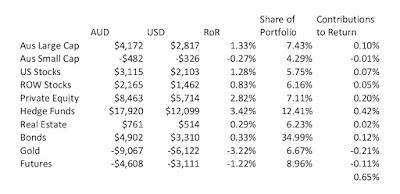This month the stockmarket rose at a slower pace.
This month, our spending was again low relative to pre-COVID-19. We spent AUD 5.3k which is up on April's AUD 4.6k.
The Australian Dollar rose from USD 0.6524 to 0.6647. The MSCI World Index rose 4.41%, the S&P 500 4.76%, and the ASX 200 4.42%. All these are total returns including dividends. We gained 2.49% in Australian Dollar terms and 4.40% in US Dollar terms. The target portfolio is expected to have gained 1.53% in Australian Dollar terms and the HFRI hedge fund index 1.69% in US Dollar terms. So, we strongly out-performed these latter two benchmarks and matched the MSCI return.
Here is a report on the performance of investments by asset class:
This month, our spending was again low relative to pre-COVID-19. We spent AUD 5.3k which is up on April's AUD 4.6k.
The Australian Dollar rose from USD 0.6524 to 0.6647. The MSCI World Index rose 4.41%, the S&P 500 4.76%, and the ASX 200 4.42%. All these are total returns including dividends. We gained 2.49% in Australian Dollar terms and 4.40% in US Dollar terms. The target portfolio is expected to have gained 1.53% in Australian Dollar terms and the HFRI hedge fund index 1.69% in US Dollar terms. So, we strongly out-performed these latter two benchmarks and matched the MSCI return.
Things that worked well this month:
- Regal Funds and Pershing Square Holdings were the top performing assets in dollar terms. Some other listed hedge funds (Cadence, Tribeca) also did well.
- Gold.
- CFS Developing Companies Fund.
- Pengana Private Equity.
- Domacom continued to rebound from the lows of March.
- Winton Global Alpha managed futures fund lost 4.6%. I now have lost money overall from investing in this. Is trend-following really dead?
On a regular basis, we invest AUD 2k monthly in a set of managed funds, and there are also retirement contributions. Other moves this month:
- Dish and Scorpio Tankers bonds matured, releasing USD 50k plus interest.
- I invested AUD 100k in the APSEC hedge fund.
- I bought 20,000 more shares of the Tribeca Global Resources Fund (TGF.AX).
- I sold 20,000 shares of Pengana Private Equity (PE1.AX) when the price rose a lot above net asset value.











































